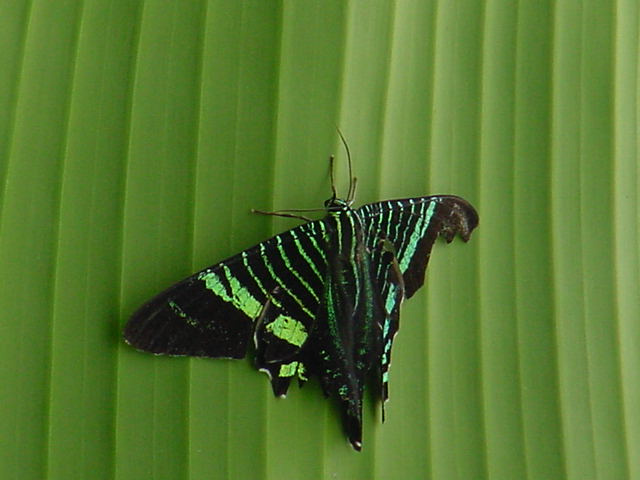
More about Green Page Moth
Habitat
This moth lives where it can find the liana it needs as a caterpillar. The liana, Omphalea diandra, grows in wet forest and swamp forest areas, often close to mangrove zones.
Range
This moth survives in forest pockets with Omphalea from southeastern Mexico down to Brazil and northern Ecuador.
Physical Description
Intuition might mistake this for a butterfly at first, but the Green Page is a moth that is active during the day. With a pattern of alternating iridescent black and green stripes, long white-tipped tails, and a large shape similar to that of a swallowtail butterfly, the Green Page is a striking moth to come across.
The caterpillar is usually striped in black and white with long black hairs. Its head is spotted black on red. The caterpillar seals two leaves around itself before forming the yellow-brown pupa.
Biology and Natural History
Also called the Green Urania, this moth has an unusual migration cycle. Every 4 to 8 years, local populations will relocate en masse to another region. The spectacular migration is stimulated by the relationship this moth has to its host plant. Omphalea contains poisons to discourage animals from eating it. The green moth caterpillar can tolerate this without dying, and these toxins help protect the caterpillar from predators. Over a few years, though, the Omphalea slowly increases the level of its poison. When the plant becomes too toxic for the caterpillars to eat, adult moths begin a migration to a region where the Omphalea has a lower toxicity. They leave in July or August and travel for several months. The next March, the moths will return to where their population began.
The migration path depends on the subpopulation. In numbers up to hundreds of thousands, the moths blanket trees as they roost together along the way. Each population of the Green Page moves generally in an east or southeast direction to a new patch of Omphalea.
Diet
The caterpillars of this moth eat Omphalea diandra in countries like Costa Rica. As adults, the diet switches to flower nectar. They are partial to the white, fluffy flowers of certain legume plants.
Height/Weight
The wingspan of this moth is about 10 cm and the body is about 6 cm from head to tail. The larvae grow to 5 cm in length.
Taxonomy
Order: Lepidoptera
Family: Uraniidae
Sources
Henderson, Carrol L. Field Guide to the Wildlife of Costa Rica. University of Texas Press, Austin, 2002.
Hogue, Charles L. Latin American Insects and Entomology. University of California Press: Berkely and Los Angeles, 1993.
-Amy Strieter, Wildlife Writer
Similar Profiles
We believe travel is more than ticking destinations off a list – it’s about discovering new places deeply, feeling connected wherever you go, and knowing you have a trusted team behind you every step of the way.



